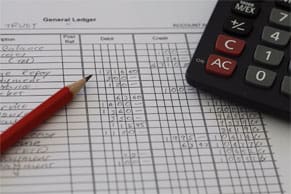The accounting cycle restarts a dozen times per year for most companies. As one fiscal month closes and the next begins, companies must make adjusting journal entries to ensure a clean cutoff for the period. Making adjusting journal entries is especially important for businesses that use the accrual basis of accounting — where revenue and expenses are recorded as they are earned and incurred, regardless of when money exchanges hands — because it improves the precision of account balances used in financial statements and management analyses.
Nonetheless, the process can be time-consuming and prone to errors, especially in accounting environments that aren’t automated. This article explores the most common types of adjusting entries, why they are important and how to best manage the process to create timely, accurate and useful accounting data.
What Are Adjusting Entries?
Adjusting entries are general ledger (GL) journal entries that occur at the end of an accounting period to record any unrecognized transactions for that period. Most journal entries are recorded via a subsidiary system, such as customer invoicing and accounts payable — the bulk of the debits and credits that populate a business’s GL on a daily basis. During the accounting close at the end of each fiscal period, accountants run an unadjusted trial balance that summarizes the balance in each GL account. The balances are then analyzed and adjusted to ensure that they include any transactions that were not captured during the period. These adjusting entries are recorded, resulting in an adjusted trial balance that lists the final balances in each GL account.
There are three major types of adjusting entries: accruals, deferrals and estimates. Accountants use accruals and deferrals to shift the timing of items in the books to comply with the accounting principles of revenue recognition, which recognizes revenue in the period in which it was earned rather than the period in which cash is received, and matching, which matches expenses to the related revenue in the same accounting period. Accruals pull future cash transactions into the current period and deferrals push them into the future. Estimates, meanwhile, are adjusting entries that typically involve non-cash items, such as depreciation and amortization, and ensure that the value of assets and liabilities is accurate, and that revenue and expenses are matched in the right period. Regardless of type, adjusting entries typically impact a business’s balance sheet and income statement, so it’s important to get them right.
Key Takeaways
- Adjusting entries help companies that use accrual accounting improve the accuracy of account balances used in financial statements and management analyses.
- Adjusting entries arise from periodicity, the accounting assumption that deals with dividing ongoing business results into distinct portions of time, such as months, quarters or years.
- The three main types of adjusting entries are accruals, deferrals and estimates.
- Adjusted entry accounting is an important but potentially cumbersome part of the normal accounting cycle that can be best managed with the right accounting software.
Accounting Adjustments Explained
Adjusting entries can be thought of as quality control tools that help keep a company’s accounting data in compliance with Generally Accepted Accounting Principles (GAAP) and International Financial Reporting Standards (IFRS). They help ensure that revenue is properly reflected in the period in which it has been earned, not just invoiced or collected, and that expenses are reported in the period in which they have been incurred, regardless of when payment is made. Adjusting entries often require some judgment on the part of accountants, based on their knowledge of the business. For example, accounting adjustments are sometimes made to correct an error or to reconcile an item found during the accounting close, such as a bank charge uncovered as part of the cash account reconciliation. Most adjusting entries, however, repeat regularly.
Types of Accounting Adjustments
Accounting adjustments are a normal part of the accounting cycle. They are meant to finely tune the accounting data so it’s more complete, up to date and accurate. There are several types of accounting adjustments and variations within each type. Let’s take a closer look.
Accruals
Accruals are transactions that have occurred, but cash hasn’t yet been exchanged and the transactions haven’t yet been recorded in a company’s GL. Accountants use adjusting entries to reconcile this discrepancy in timing. For example, accruals are typically automatically reversed the following month, when transactions are completed through the typical processing channels, such as customer invoicing and payment of a company’s bills. Accrual adjustments come in two varieties — revenue accruals and expense accruals.
A revenue accrual is a sale that has been earned, but the customer has not yet been invoiced. For example, if an electrician completed a repair at a customer’s home on March 28 and hasn’t invoiced the customer by the end of the period on March 31, a revenue accrual would be recorded to include the revenue in fiscal March. The adjusting entry made during the March accounting close increases revenue and accounts receivable for that accounting period and looks like this:
| GL Account for March | Debit | Credit |
|---|---|---|
| Accounts receivable — Customer #1234 | $1,000 | |
| Accrued revenue — Electrical repairs | $1,000 |
An expense accrual accounts for products delivered or services rendered for which the business has not yet received a bill. For example, if a company rents office space during March but doesn’t receive the bill from the landlord until April, an expense accrual would be recorded to properly reflect rent expenses in the month of March. The adjusting entry during the March accounting close increases rent expense and accounts payable and looks like this:
| GL Account for March | Debit | Credit |
|---|---|---|
| Rent expense — 200 1st Street | $10,000 | |
| Accounts payable — Joe Landlord | $10,000 |
Deferrals
Deferrals delay the recognition of transactions that occur in the current period to a future accounting period. When dealing with deferrals, two journal entries are involved — an initial entry that records the transaction and an adjusting entry at a later date. Like accruals, deferrals come in two varieties — revenue deferrals and expense deferrals. A revenue deferral is necessary when a company invoices or receives payment from a customer before delivering the goods or services. It’s not uncommon for customer invoicing to be on a more accelerated schedule than the work, especially for projects that happen over time or involve retainers or deposits. The initial entry records the payment. The adjusting entry occurs in the future to recognize the revenue when it is earned. Consider a catering company that requires a customer deposit to reserve a future event and collects that deposit in February 2023 for the event scheduled in October 2024. The initial entry, made in February 2023, increases cash and establishes a liability for the deferred revenue as follows:
| GL Account for February | Debit | Credit |
|---|---|---|
| Cash — Smith wedding 10/12/2024, event #9876 | $10,000 | |
| Deferred revenue — Client deposits | $10,000 |
When the caterer produces the wedding, the revenue is considered earned and the caterer makes an adjusting entry during the October 2024 accounting close that eliminates the liability and increases revenue. Here’s what that looks like:
| GL Account for October | Debit | Credit |
|---|---|---|
| Deferred revenue — Client deposits | $10,000 | |
| Catering revenue — Smith wedding 10/12/2024, event #9876 | $10,000 |
An expense deferral is an adjusting entry that is necessary when a company makes a payment in advance of when the expense is actually incurred. Since a deferred expense represents services or products that have been prepaid and has future economic benefit, it is classified as an asset. The asset is reduced and converted to an expense as incurred, which requires an adjusting entry. A popular example of an expense deferral is when a company pays the entire premium for its annual insurance policy in advance. For instance, if a company prepays its annual premium in December 2023 for a policy covering calendar year 2024, the initial entry made in December 2023 establishes the prepaid asset (deferred expense) and reduces cash for the amount paid as follows:
| GL Account for December | Debit | Credit |
|---|---|---|
| Prepaid insurance – 200 1st Street | $12,000 | |
| Cash — Dwelling insurance | $12,000 |
As each month under the policy elapses, one-twelfth of the premium is considered incurred and the company makes an adjusting entry to reflect that period’s insurance expense and reduces the prepaid asset by the same amount. During each monthly accounting close in 2024, an accountant makes the adjusting entry shown below so that the final balance of the deferred expense on December 31, 2024, is zero.
| GL Account | Debit | Credit |
|---|---|---|
| Insurance expense — 200 1st Street | $1,000 | |
| Prepaid insurance — 200 1st Street | $1,000 |
Estimates
Estimates are adjusting entries that usually involve non-cash transactions. They accurately reflect the value of assets and liabilities on a business’s balance sheet, and they recognize likely expenses on the income statement in accordance with the accounting principles of matching and conservatism, the latter of which requires company accounts to be prepared with caution and a high degree of verification. Accountants make rational estimates using their judgment and GAAP-compliant methods. One example of adjusting entries for estimates is inventory reserve. Over time, a company’s accountant may observe that a certain percentage of inventory on hand consistently becomes unsellable due to damage, loss or obsolescence. As a result, an adjusting entry to establish (or change) an inventory reserve improves the accuracy of inventory value on the balance sheet and records an expense on the income statement in the right period. The adjusting entry reduces the value of inventory and increases the company’s cost of goods sold as follows:
| GL Account | Debit | Credit |
|---|---|---|
| Cost of goods sold — 5% reserve | $50,000 | |
| Inventory reserve — 5% reserve | $50,000 |
Depreciation and Amortization
Depreciation and amortization are specific examples of adjusting entries that fall under the broader category of estimates. Accountants use them to allocate the cost of long-lived assets over the period of time they are expected to be in service. Broadly speaking, depreciation applies to fixed assets, such as buildings, vehicles and manufacturing equipment, while amortization applies to intangible assets, such as patents and licenses. The systematic, periodic write-down of these assets is done using adjusting entries during the accounting close. The amount of each entry is calculated using a GAAP-approved method, such as straight-line depreciation. Consider a company with $1.2 million of equipment that is expected to be worthless after a 10-year useful life. The company uses the straight-line depreciation method to calculate an adjusting entry that increases the depreciation expense on the income statement by $10,000 every month and reduces the carrying value of the equipment on the balance sheet as follows:
| GL Account | Debit | Credit |
|---|---|---|
| Depreciation expense — Warehouse equipment | $10,000 | |
| Accumulated depreciation — Warehouse equipment | $10,000 |
How to Make Adjusting Entries
Adjusting journal entries follow the standard rules of double-entry accounting in that they change the balance of at least two GL accounts using equal amounts of debits and credits. For companies with manual accounting systems, accountants log adjusting entries using spreadsheets. This can become cumbersome because of the significant number of potential adjustments, causing many bookkeepers to maintain offline “closing checklists” to try to stay organized. Moreover, manual processes make it increasingly difficult for accountants to keep track of when adjustments need to be made in future periods.
In contrast, companies that use automated journal-entry software can set adjusting entries to automatically reverse in a future period. This helps businesses avoid accidentally double counting accrual adjustments since accrued transactions are eventually processed during the invoicing or accounts payables process. Software applications can also automate adjusting entries like depreciation expenses to recur every accounting period to make sure they aren’t overlooked.
When to Make Accounting Adjustments
Accounting adjustments are a significant part of the accounting cycle. Most accounting adjustments arise from periodicity — the accounting assumption that deals with dividing business results into distinct portions of time — and they should be made prior to closing the books and resetting the accounts for the next accounting cycle. Accountants make the majority of adjusting entries after creating the unadjusted trial balance and before running the adjusted trial balance. Sometimes adjusting journal entries arise from items discovered during account reconciliations, such as when GL cash account activity is compared with bank statements. The account balances on the adjusted trial balance flow into a business’s financial statements. Therefore, adjusting entries should be made at a minimum whenever financial statements are created, typically monthly, quarterly or annually.
Adjusting Journal Entry Example
Beyond the examples discussed above, another common adjusting journal entry addresses customer receivables that are estimated to go uncollected. When a business sells to customers on credit, it sends invoices and expects payment in accordance with invoice terms. It’s typical that some percentage of a business’s invoices are never collected and subsequently written off as a bad debt expense. To ensure that a company presents its accounts receivable balance more accurately, GAAP requires an estimate of the expected uncollectible amount to be recorded in the same period as the related revenue. A general reserve is usually estimated based on past history and recorded as an adjusting entry. This reserve is called an allowance for doubtful accounts and reduces the value of accounts receivable on the balance sheet and increases the bad debt expense on the income statement.
For example, if Company XYZ records $100,000 in credit sales during the month of September and has observed that write-offs for the year have been averaging 5%, it would record the following adjusting journal entry during its September accounting close:
| GL Account for September | Debit | Credit |
|---|---|---|
| Bad debt expense | $5,000 | |
| Allowance for doubtful accounts | $5,000 |
Why Are Adjusting Journal Entries Important?
Adjusting journal entries help make a business’s account balances more accurate and useful, which is especially important when it comes to filing tax returns. They provide a way to account for items that were included in the normal course of transaction processing and items that cross multiple fiscal periods in accordance with the principles of accrual accounting. Accrual adjustments remedy errors of unrecorded revenue and expenses. Deferral adjustments resolve proper cutoff of deferred revenue, expenses, depreciation and amortization. Adjusting entries for estimates add precision to account balances.
It's important for businesses to adjust for all these items so that their balance sheets are correctly valued and income statement activity is reflected accurately and in the correct accounting period.
Automate Adjusting Entries With NetSuite
For most businesses, many items on the GL require adjusting entries. Some adjusting entries are straightforward based on standard calculations, such as a reserve for inventory obsolescence or an allowance for doubtful accounts. In addition, adjusting entries are often recurring. NetSuite cloud accounting software automates adjusting entries, reducing the likelihood that something gets overlooked during the accounting cycle close. The software lets businesses set and schedule adjustments, such as monthly depreciation entries and accruals for interest expenses on loans, allowing accounting staff to focus on higher-value tasks. For more complex adjustments, rules-based transaction matching and automatic journal entry posting help reduce the amount of manual intervention needed. When combined with automated journal entry approval workflows, NetSuite cloud accounting software is a powerful tool for handling adjusting entries so that a business can close its books faster and more accurately.
Businesses maintain continuous, fluid operations, but periodicity and other accounting assumptions and principles impose strict fiscal periods on financial statements. Adjusting entries, such as accruals, deferrals and estimates, help businesses ensure that their accounting data accurately reflects the values and activity of a given accounting period. Accounting software automates adjusting entries and can help companies streamline their accounting cycle processes, freeing up financial staff to engage in higher-value tasks that can benefit the business.
Accounting Adjustment FAQs
What is an adjusting entry in accounting?
Adjusting entries are journal entries in a company’s general ledger that occur at the end of an accounting period to record any unrecognized transactions for that period. Accountants make the majority of adjusting entries after creating the unadjusted trial balance and before running the adjusted trial balance. Adjusting entries help ensure that revenue is properly reflected in the period in which it was earned, not just when it was invoiced or collected, and that expenses are reported in the period in which they were incurred, regardless of when payment was made. Adjusting entries often require some judgment on the part of accountants, based on their knowledge of the business. For example, accounting adjustments are sometimes made to correct an error or to reconcile an item found during the accounting close, such as a bank charge uncovered as part of the cash account reconciliation. Most adjusting entries, however, repeat regularly.
What are examples of adjusting entries?
There are three major types of adjusting entries — accruals, deferrals and estimates. An example of a revenue accrual is a sale that has been earned, but the customer has not yet been invoiced by the time the books are closed. An expense accrual accounts for products delivered or services rendered, but the business has not yet received a bill, such as rent paid in arrears. A revenue deferral is necessary when a company invoices or receives payment from a customer before delivering the goods or services, as is the case for customer deposits. An expense deferral is an adjusting entry that is necessary when a company makes a payment in advance of when the expense is actually incurred, such as prepaid insurance premiums. Estimates are adjusting entries that usually involve non-cash transactions, such as inventory reserve for obsolescence and depreciation.
What are the five adjusting entries?
Five common adjusting entries are revenue accruals, expense accruals, revenue deferrals, expense deferrals and estimates. Depreciation and amortization are specific types of adjusting entries that fall under the broader category of estimates.
What are the four adjusting entries?
References to the four adjusting entries typically relate to revenue accruals, expense accruals, revenue deferrals and expense deferrals.
Why make adjusting entries?
Adjusting journal entries make account balances more accurate and useful. Businesses maintain ongoing operations, but financial statements artificially divide results into fiscal periods. Adjusting entries help ensure that the accounting data accurately reflects the values and activity of the period presented.
Who needs to make adjusting entries?
Making adjusting journal entries is important for companies that use the accrual basis of accounting — where revenue and expenses are recorded as they are earned and incurred, regardless of when money exchanges hands — because doing so improves the precision of account balances used in financial statements and management analyses.
What accounts are affected by an adjusting entry?
Adjusting journal entries follow the standard rules of double-entry accounting. They change the balance of at least two general ledger accounts using equal amounts of debits and credits. Adjusting entries typically cause changes to both the balance sheet and the income statement, so it’s important to get them right.
What is the distinction between cash and accrual accounting?
Cash accounting recognizes revenue and expenses when cash is received and when cash is paid out. The cash basis is used by many small companies, but it’s not GAAP-compliant. Accrual accounting is a GAAP-compliant method that recognizes revenue when it is earned and expenses when they are incurred. Accrual accounting uncouples the timing of when transactions are reflected from the flow of cash.









